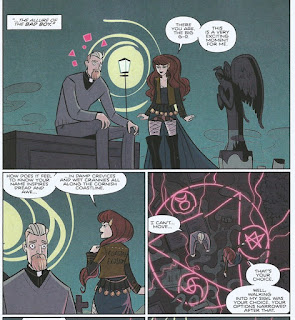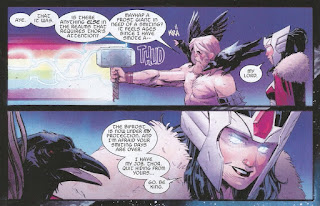Pick of the Brown Bag
January 2, 2020
by
Ray Tate
Welcome to the Pick of the Brown Bag, freshly minted for 2020. This first week our contenders include Detective Comics, Hawkeye Free Fall, Kill Lock, Red Hood and the Outlaws, Steeple, Thor, Vampire State Building and The Web of the Black Widow. If you haven't any time for the blog or just need a thumbs up or down decision at the comic shop, check me out on Twitter: #PickoftheBrownBag.
Witch Fest comes to Tredrygen. Curate Billie under the impression that it's about feminism is only too happy to volunteer.
Maggie, a Satanist, may seem particularly devilish in this scene, but it's more impish. Love her little victory dance. When Billie actually gets to the nitty gritty of the affair, Maggie protects her from the darker aspects of witchery.
The same cannot be said for the Great Destroyer a.k.a. Reverend Penrose. So named because he frequently battles the monsters that rise from the sea. Although even he gets away lightly. The witch in question is more mischievous than damaging.
Once again, creator/writer/artist John Allison with colorist Sarah Stern creates a charming, hilarious comedy in the bizarre little Welsh town.
Unlike some humorous ventures, Steeple is character-based, rather than joke-based. The comedy evolves from the conflicts in monster fighting and basic philosophy. Each story enriches the characterization of the cast as they interact, clash but also tolerate and cooperate.
Vampire State Building focuses on escaping protagonists trapped in an elevator with vampires scrabbling for the doors, scaling the shaft and dropping down upon the roof. Meanwhile, the SWAT teams of the NYPD came to the conclusion where none of the upper levels of government can arrive.
They're not fighting humans. They're fighting the undead. They know better to say such madness, but they know it. In a previous issue, the vampires refused to go down under a hail of bullets. They've discovered fire is their friend and adjusted accordingly.
The central coolness of the story derives from taking traditional vampires and having them swarm the Empire State Building. The intellect comes from the way the vampires propagated, and the fun lies in the evening of the odds. The SWAT guys have a satisfying strategic plan to fight the vampires.
It all works because of Charlie Adlard's realistic artwork contrasting with horrific imagery. He further demonstrates palpable fear from the victims, terror from the vampires and professionalism from SWAT.
The central coolness of the story derives from taking traditional vampires and having them swarm the Empire State Building. The intellect comes from the way the vampires propagated, and the fun lies in the evening of the odds. The SWAT guys have a satisfying strategic plan to fight the vampires.
It all works because of Charlie Adlard's realistic artwork contrasting with horrific imagery. He further demonstrates palpable fear from the victims, terror from the vampires and professionalism from SWAT.
Kill Lock is a strange little item from IDW and triple threat Livio Ramondelli. Certain engineers see robots as a way to perpetuate our species. They see them as the creature most likely to meet alien in space. They foresee a time when our robots will be astronauts representing humanity. These designers have a better grip on reality than say the Blade Runner visionaries out to establish a working sex robot. Kill Lock seems to based on the premise of robots not servants but our progression.
The planetary setting appears to be solely inhabited by robots. Stop me if you've heard this one, but two robots are in a bar.
This scenario doesn't go where you think it will. The Kill Lock is a designation for robot criminals such as the square-headed antagonist. We get to see exactly what he's in for, and it's rather chilling. Think of Futurama's Roberto the shabby robot only more dramatic.
As the story unfolds, we meet other robots in the cast of criminal mech. Including the bounty-killers. We also discover the meaning behind the Kill Lock which neatly explains why the four work together. They have no choice.
The planetary setting appears to be solely inhabited by robots. Stop me if you've heard this one, but two robots are in a bar.
This scenario doesn't go where you think it will. The Kill Lock is a designation for robot criminals such as the square-headed antagonist. We get to see exactly what he's in for, and it's rather chilling. Think of Futurama's Roberto the shabby robot only more dramatic.
As the story unfolds, we meet other robots in the cast of criminal mech. Including the bounty-killers. We also discover the meaning behind the Kill Lock which neatly explains why the four work together. They have no choice.
Stan Lee and Jack Kirby charged the Norse myths by relating them anew in Journey to Mystery. It’s fair to say that ordinary people as opposed to academics know more about Norse mythology because of them.
Odin is king of Asgard and the maker of the world. His sons Thor and Loki, gods of Storm and Magic.
Kirby and Lee introduced the Norse gods and the subjects of Asgard as powerful, ancient aliens. Their magic is science yet to be understood. By debuting the Aesir as mortal, albeit long-lived, Lee and Kirby planted the idea that Asgard need not remain the same.
Genuine change began in the eighties. A being named Beta Ray Bill succeeded in defeating Thor in fair combat. Thus Bill acquired the hammer Mjolnir and the power of the Thor. Others like Jane Foster would follow.
Odinson is once again Thor and the bearer of Mjolnir, but new writer Donny Cates debuts the new Thor comic book with change in mind. Odin is gone. Thor is the King of Asgard. He even has the ravens.
Sif assumed the role of Heimdall. She guards the Bifrost and watches all that transpires in the universe. These are not spoilers. Not major ones anyway. Loki is the King of the Frost Giants, and a more or less welcome sight at the court of Asgard.
More or less.
The changes honestly amount to a reshuffling of personnel. Few of them a product of the current writer in fact. Cates however upends expectations when Galactus pays his respects. The Power Cosmic seeks not to devour Asgard, but to warn Thor of a cryptic threat.
With Galactus incapacitated, Thor summons the entity’s former Heralds to decode his message. They get only so far but the Silver Surfer arrives with the key.
Detective Comics opens with a weird Viking ceremony in seventeenth century Gotham.
This in itself is a puzzle since the Vikings were already long gone and never actually visited the United States. Somehow the enigma pertains to Batman’s twenty-first century investigation.
The contemporary story also addresses Tom King's quintessential Batman run, which just finished. Batman must not shirk his duties as a dog-lover, he must allow himself to fall asleep. As Bruce Wayne, he cedes to the duties of his family crest. Tomasi also nods to Big Stupid Event The Infected by taking Commissioner Gordon off the board. Batman amusingly must interact with police from various ranks. Demonstrating a different facet of his being.
Tomasi once again creates a fascinating murder mystery loaded with clues directing a ratiocinator like Batman to a smart conclusion. He sets the story in a richly casted Gotham City, including Harvey Bullock. It’s too early to compare Tomasi’s latest to his masterful Arkham Knight, and yet, I’m getting that vibe.
Tomasi once again creates a fascinating murder mystery loaded with clues directing a ratiocinator like Batman to a smart conclusion. He sets the story in a richly casted Gotham City, including Harvey Bullock. It’s too early to compare Tomasi’s latest to his masterful Arkham Knight, and yet, I’m getting that vibe.
Bizarro and Artemis returned in the last Red Hood and the Outlaws. We confirm in this issue, they’re not in their right minds.
Previously, Bizarro wiped out the Red Hood with a single clap.
Not to worry. He gets better. This isn’t as zany as other issues of Red Hood, but it’s consistently amusing. David Messina’s artwork is also consistently appealing. However, the reason I’m talking about Red Hood can be found in the conclusion.
Scott Lobdell loves Jason Todd, and knows everything about his era, which actually began in the Bronze Age and carried over to the post-Crisis. The ending demonstrates Jason's elliptical growth and the redemption of another.
Look up Mary Sue in the dictionary and you’ll see a picture of the Hood.
Brian Bendis didn't create the Hood. He nevertheless fell hopelessly in love with the thug and used him to vent his distaste for Tigra. Through Bendis' actions, the Hood creates a snuff film in which he beats Tigra to near death. I won't dwell on how Bendis facilitates the Hood's crime. Suffice to say, the plot devices are contrived.
Tigra is my favorite Marvel character. I fell in love with her at first sight in Marvel Team-Up. That is why I will never pick up a Brian Bendis book again.
Marvel Team-Up #67
Thank you Matt Rosenberg, and thank you, Clint Barton. Hawkeye humiliates the Hood. That’s just one of the pluses in Hawkeye's new mini-series Freefall.
Writer Matthew Rosenberg has an ear for Hawkeye dialogue, and he takes pleasure in presenting the whole man: his cockiness, his skill, his professionalism and his humor.
Writer Matthew Rosenberg has an ear for Hawkeye dialogue, and he takes pleasure in presenting the whole man: his cockiness, his skill, his professionalism and his humor.
Guest stars include Bucky and the Falcon. They’re interested in Clint for another facet of Hawkeye. Sometimes Clint isn’t Hawkeye.
Honestly, I know more about the Frankenheimer/Mamet film than I do about Marvel's Ronin. Remember, my commentary about Bendis? I am however aware of Hawkeye turning to Pym Particles to become Goliath in the sixties. Fortunately, Rosenberg succinctly explains the ins and outs of Ronin.
The former Captain America partners team up to investigate the new Ronin. They find themselves wistfully overwhelmed, but there’s one good thing about the fiasco.
Jody Houser's Web of the Black Widow concludes with some really good spy craft. She forces the reader to rethink everything we learned in the previous chapters.
Houser also does something rare in Marvel Comics. She utilizes Black Widow's clone history in a subtle way that also laces in some fascinating science fiction.
Houser singles out the Marvel Universe as the place where memories can be uploaded. The Gwen Stacy clone didn't just appear identical, she had the memories of the original up to a certain point. The same can be said for the Spider clones as well as Iron Man, twice.
Natasha's memories were uploaded into a clone body, that the Red Room kept handy, or something like that. I'm not entirely a fan of Red Room stories or Marvel clone tales. So I skipped the rebooted Tales of Suspense. I only know of the recent history from hearsay in other Black Widow minis and appearances. Why doesn't Black Widow have an ongoing book? In any case, Web isn't actually about the Red Room or cloning. Houser just borrows these concepts as tools for the villain of the piece.
So, without spoiling anything. The finale features guest-appearances by those having prior cameos. The second Black Widow Yelena, Iron Man and Hawkeye take their bows. An undisclosed associate of the Black Widow makes a timely entrance.
If only the villain of the piece Anya actually meant something this would be a grade A Black Widow story, but A minus isn't too bad at all.

































No comments:
Post a Comment